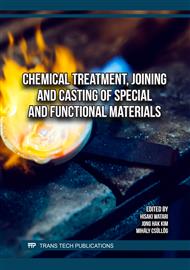[1]
L. Winardi, H.E. Littleton, C.E. Bates: Pressures in Sand Cores, AFS Transactions, vol.115., Paper 07-062(04).pdf, (2007) 303-312
Google Scholar
[2]
Y. Maeda1, H. Nomura, Y. Otsuka, H. Tomishige, Y. Mori "Numerical simulation of gas flow through sand core" Int. J. Cast Metals Res., (2002), 15, 441-444
DOI: 10.1080/13640461.2003.11819525
Google Scholar
[3]
Laurentiu Nastac, Shian Jia, Mihaela N. Nastac & Robert Wood: Numerical modeling of the gas evolution in furan binder-silica sand mold castings- International Journal of Cast Metals Research VOL. 29. NO. 4, (2016) 194-201
DOI: 10.1080/13640461.2015.1125983
Google Scholar
[4]
Hassan Khawaja: Semi-implicit method for pressure-linked equations (SIMPLE) ⇓ solution in MATLAB- Int. Jnl. of Multiphysics Volume 12, Number 4, (2018) 313-325
DOI: 10.21152/1750-9548.12.4.313
Google Scholar
[5]
Worman, R.A., Nieman, J.R.: A Mathematical System for Exercising Preventive Control over Core Gas Defectes in Gray Iron Castings, TAFS 81, (1973) 170–179
Google Scholar
[6]
A. Starobin, D. Goettsch, M. Walker, D. Burch: Gas Pressure in Aluminum Block Water Jacket Cores, International Journal of Metalcasting/Summer, (2011) 57-64
DOI: 10.1007/bf03355518
Google Scholar
[7]
A.J. Starobin and C.W. Hirt: FLOW-3D Core Gas Model: Binder Gas Generation and Transport in Sand Cores and Molds- Flow Science Report 04-14 (2014)
Google Scholar
[8]
Andrei Starobin, C.W. Hirt, D. Goettsch: A Model for Binder Gas Generation and Transport In Sand Cores And Molds, Modeling of Casting, Welding, and Solidification Processes XII TMS (The Minerals, Metals & Materials Society) (2009)
Google Scholar
[9]
P. Scarber, C.E. Bates, "Simulation of Core Gas production During Mold Fill,", AFS Transaction, vol. 114, paper no. 138 (2006)
Google Scholar
[10]
S.Ravi, J. Thiel: Prediction of Core Gas Pressure from Chemically Bonded Sand Molds Using Process Simulation Software, AFS Transactions, Paper 17-097 v125 - Page 1 of 8 (2017)
Google Scholar
[11]
KIMATSUKA Akihiko, KUROKI Yasunori: Mold Filling Simulation for Predicting Gas Porosity, Engineering Review, Vol. 40. No. 2., pp.83-88 (2007)
Google Scholar
[12]
IKO-Erbslöh, Jörg Baier, Martin Köpper: Manual of Casting Defects, Incidence and avoidance of defects attributable to molding sands, (1994), P: 51-55.
Google Scholar
[13]
P.Scraber, C.Bates, J.Griffin: Avoiding gas defects through mould and core package design. Modern Casting, v. 96, issue 12, (2006), pp.38-40.
Google Scholar
[14]
John Campbell: Complete Casting Handbook- 10.5. Rule 5: 'Avoid core blows' 635-659
Google Scholar
[15]
Bates CE, Monroe RW: Mold binder decomposition and its relation to gas defects in castings. AFS Trans 89:671–686 (1981)
Google Scholar
[16]
H. Gerard Levelink, F.P.M.A. Julien und H.C.J. De Man, Apeldoorn: Gasentwicklung in Formen und Kernen als Ursache von Gußfehlern, Gießerei 67 (1980) Nr. 5-3 März, S.: 109-115.
Google Scholar
[17]
Walter Schlesiger, Johannes W interhalter und Wilfried Siefer: Zur Gasabführung aus Kernen, Giesserei, Nr. 4 16. Februar, (1987) 76-84
Google Scholar
[18]
W. BAUER: Einfluß der chemischen Zusammensetzung und des Formstoffes auf Gasblasenfehler in Gußeisen, GIESSEREI-PRAXIS Nr. 12, (1984) 198-205
Google Scholar
[19]
Vivek V. Yadav, Shailesh J. Shaha: Quality Analysis of Automotive Casting for Productivity Improvement by Minimizing Rejection, International Journal of Mechanical And Production Engineering, ISSN: 2320-2092, Volume- 4, Issue-6 (2016)
Google Scholar
[20]
Doru Michael Stefanescu: Surface Quality, Penetration Defects and Casting Skin, Course Metallurgy, solidification and modeling of cast iron castings 5th edition, Presentation, Jönköping, Sweden (2017)
Google Scholar
[21]
A.Chojecki, J. Mocek: Gas pressure in sand mould poured with cast iron, Archives of Foundry Engineering Volume 11, Issue, 1/2011, 9-14
Google Scholar
[22]
Yamamoto Y et al: Gas pressure in shell mold cores made of olivine sand during casting. AFS Int Cast Met J 5(2):60–65 (1980)
Google Scholar
[23]
T. Szmigielski: Measurement of gas pressure in sand mould. Archives of Mechanical Technology 24, (2004), nr 3, pp.163-171.
Google Scholar
[24]
Toth L., Nandori Gy.: Verringerung gasbedingter Fehler in Gußstücken, Sov. Cast Technol. P. 4-7 (engl.) Litejnoe proizvodstvo 1988, P- 6-7 (russ.) (1988)
Google Scholar
[25]
J. Svidró, A. Diószegi, L. Tóth, J.T. Svidró: The Influence of Thermal Expansion of Unbonded Foundry Sands on The Deformation of Resin Bonded Cores, Arch. Metall. Mater. 62 (2017), 2, 795-798, Doi: 10.1515/Amm-2017-0118 (2017)
DOI: 10.1515/amm-2017-0118
Google Scholar
[26]
M. Divandari, J. Campbell: Morphology of oxide films of Al–5Mg alloy in dynamic conditions in casting, International Journal of Cast Metals Research 2005 Vol. 18 No. 3 P. 187-192, (2005)
DOI: 10.1179/136404605225023000
Google Scholar
[27]
John Campbell: Leakage Defects Via Bubble Trails In Grey Iron Castings, International Journal of Metalcasting/Fall 07-20 (2007)
DOI: 10.1007/bf03355414
Google Scholar
[28]
Gábor Gyarmati, Gy. Fegyverneki, T. Mende, M. Tokár: Characterization of the double oxide film content of liquid aluminum alloys by computed tomography, Materials Characterization 157, 109925https://doi.org/10.1016/j.matchar.2019.109925 (2019)
DOI: 10.1016/j.matchar.2019.109925
Google Scholar
[29]
G. Gyarmati, Gy. Fegyverneki, Z. Kéri, D. Molnár, M. Tokár, L. Varga, T. Mende : Controlled precipitation of intermetallic (Al,Si)3Ti compound particles on double oxide films in liquid aluminum alloys, Materials Characterization, Volume 181, 111467 (2021)
DOI: 10.1016/j.matchar.2021.111467
Google Scholar
[30]
S.Ravi, J. Thiel: Prediction of Core Gas Pressure from Chemically Bonded Sand Molds Using Process Simulation Software, AFS Transactions, Paper 17-097 v125 - Page 1 of 8 (2017)
Google Scholar
[31]
A.Chojecki, J. Mocek: Gas pressure in sand mould poured with cast iron, Archives of Foundry Engineering Volume 11, Issue, 1/2011, 9-14 (2011)
Google Scholar
[32]
M. B. Djurdjevic, Z. Odanovic, J. Pavlivic-Krstic: Melt Quality Control az aluminum Casting Plants, MJoM Vol 16 (1) 2010 pp.63-76) (2010)
Google Scholar
[33]
G. Gyarmati, Gy. Fegyvereneki, M. Tokár: The effects of rotary degassing treatments on the melt quality of an Al–Si casting alloy, International Journal of Metalcasting/Volume 15, Issue 1, pp.141-151 (2021)
DOI: 10.1007/s40962-020-00428-z
Google Scholar



